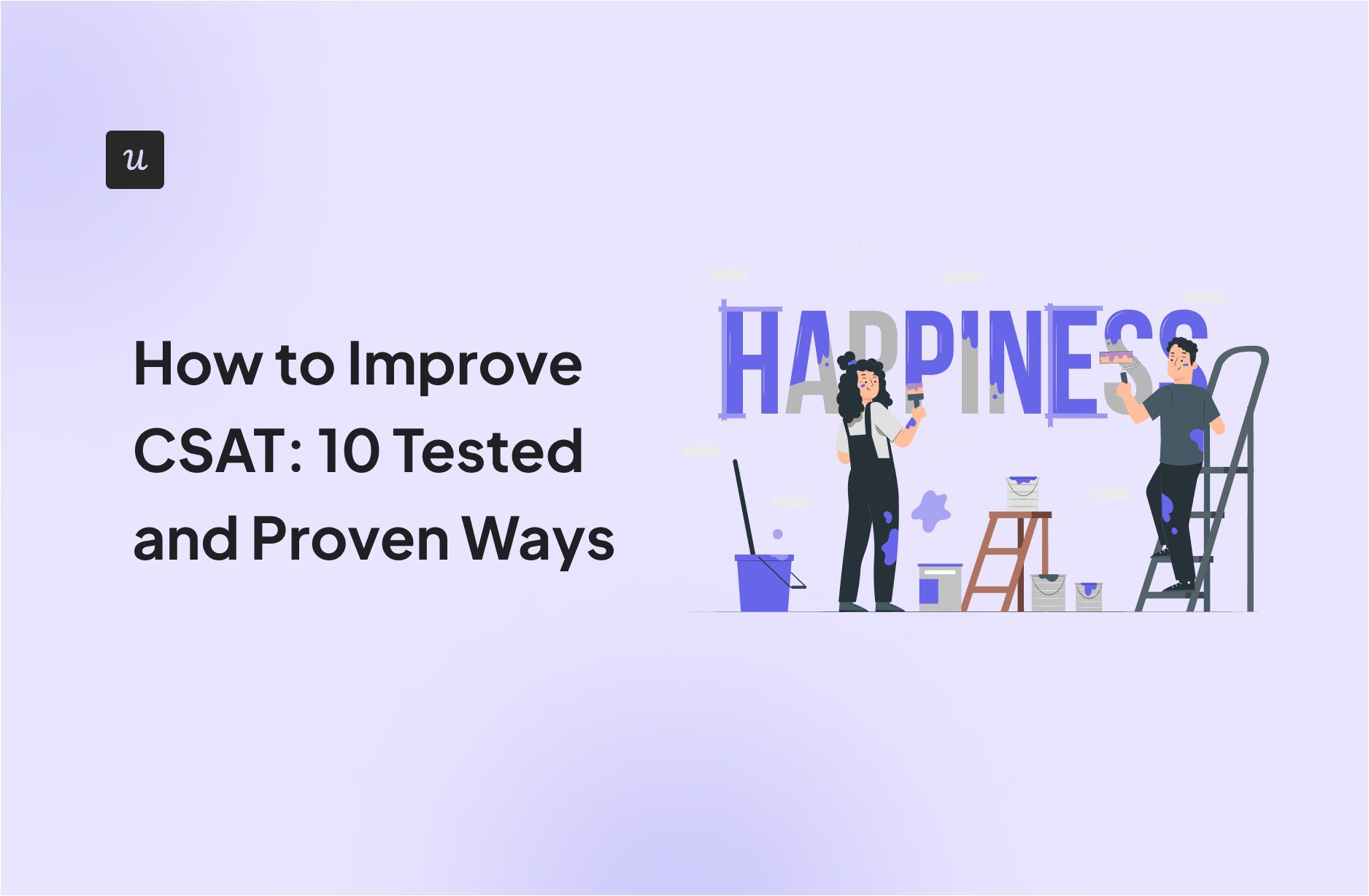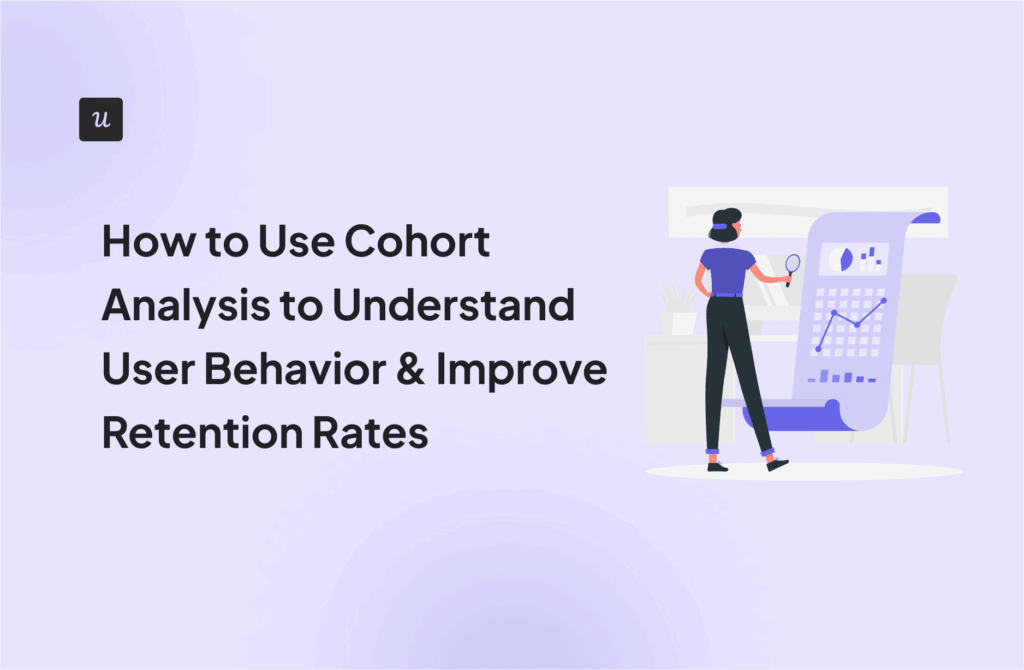
Did you know? Companies that create an emotional connection with their customers outperform their competitors by 306% in lifetime value. And the easiest way to establish this connection is by learning how to improve CSAT (customer satisfaction).
In this article, we explore proven techniques to help you increase customer satisfaction, from feedback collection to customer education and personalization. We also explore how to measure customer satisfaction and the importance of doing so.
Try Userpilot Now
See Why 1,000+ Teams Choose Userpilot

What is the customer satisfaction score (CSAT)?
The customer satisfaction score is a metric that tracks how happy and satisfied your customers feel after an interaction with your business.
You can consider it a measure of customers’ perception of your product, service delivery, or business relationship. The higher the score, the better the customer experience for the targeted interaction.
How to calculate CSAT
The first step to calculating your customer satisfaction score is data collection.
This is typically done using customer satisfaction surveys asking customers to rate their experience on a scale of 1-10 or 1-5.
Next, you need to tally up the number of positive ratings. These are 4 and 5 responses on a 1-5 rating scale or 7-10 responses on a 1-10 scale.
Finally, the CSAT is taken as the percentage of satisfied customers.
You can calculate it by dividing the number of positive responses by the total number of respondents and multiplying by 100.

What other customer satisfaction metrics can you use?
Although the customer satisfaction score is a fairly popular metric, it isn’t the only way to measure customer satisfaction.
Consider some other metrics that are just as important:
- Net Promoter Score (NPS): Unlike CSAT, NPS focuses on long-term satisfaction with your brand and not just a single interaction. It measures how likely customers are to tell others about your product.
- Customer Effort Score (CES): CES measures how much effort customers need to exert to use your product. The logic here is simple: easier products are more satisfying to use.
- Customer Retention Rate (CRR): The CRR measures the percentage of customers sticking with your product over a given period.
Why is improving customer satisfaction scores important for businesses?
Customer satisfaction directly impacts your revenue, reputation, and long-term sustainability.
Some of the key benefits of improving customer satisfaction include:
Increased customer loyalty
According to some research, a 1% shift in customer satisfaction can account for a 61.7% shift in customer loyalty. Impressive, isn’t it?
Even if its impact level differs for different businesses, customer satisfaction is directly tied to customer loyalty. The higher your CSAT scores, the higher your chances of repeat business.
Better opportunity for WoM marketing
The way customers feel about your business often shapes their narrative about your brand. When put together, these perceptions from different customers define your brand reputation.
The happier your customers are, therefore, the more likely they are to recommend your brand to others. This positive word of mouth can significantly boost your reputation, giving your business a competitive advantage.
💡Did you know?
Customers are 5.1 times more likely to recommend an organization after a positive customer experience.
Less customer churn
The more loyal customers you acquire, the less likely your customers will be to churn. This means you’ll lose fewer customers over time as you increase customer satisfaction levels.
The effect of this is multi-faceted, but the most important is on your bottom line. The more customers you hold on to, the higher (and more consistent!) your revenue.
💡Did you know?
A 5% increase in customer retention can produce an over 25% increase in profits.
10 Effective ways to improve CSAT scores
Improving customer satisfaction doesn’t happen by chance. Customer satisfaction is affected by various factors.
Let’s consider 10 effective strategies for nurturing customer satisfaction in your business:
1. Set the right goals and objectives for your CSAT
Since CSAT isn’t as obvious as customer acquisition or revenue targets, people rarely dedicate time to set goals for it. But you can’t make real progress if you don’t have clearly defined targets.
So, set goals to improve customer satisfaction based on the results you got from measuring your CSAT score.
The average CSAT score is 70-80%, but you should set your standard depending on your industry and product. Also, ensure your goals are realistic; don’t set targets that are too small for you or unreachable.
2. Personalize each customer interaction
Personalization ensures that your product is shaped to the individual’s needs, making it a more convenient tool to use. Similarly, personalized messaging and offers make users feel valued.
In fact, 71% of customers expect personalized interactions from companies. More so, 76% are frustrated when this doesn’t happen.
Therefore, personalization is key to satisfying customers and retaining their business in a world of many options.
But what is personalization? This involves tailoring your interactions and messages based on a user’s needs, preferences, and history.
For instance, helping users achieve the goal they mentioned in their welcome survey with an interactive walkthrough rather than triggering an automated product tour.
3. Use educational materials to increase the customer satisfaction score
The key to a good customer experience is knowledge – of your product, the features, and how they tie together to help the customer achieve their goals.
One way to increase customer satisfaction, therefore, is through customer education.
For example, you can use secondary onboarding flows to guide users struggling to get value from a feature.
You can also host webinars addressing core industry challenges and demonstrating your product’s value, and offer this webinar to users whose use case aligns with the subject matter.

4. Closely analyze your CSAT results
Knowing your CSAT score will do you no good if you can’t act on it. For that to happen, you must thoroughly analyze the customer feedback you receive.
- What is your survey response rate?
- What are the responses like across different user segments?
- Which features/interactions are customers the most or least satisfied with?
- What are the most common reasons for customer dissatisfaction?

💡For more insights, pair your CSAT rating question with an open-ended follow-up question so users can provide the ‘why’ behind their responses. Then, analyze the responses to find patterns you can exploit.
5. Proactively deal with negative customer feedback
It’s simply impossible for all customers to be satisfied customers. So, even if you have a pretty high CSAT score, there will always be negative customer feedback.
The key to unlocking even higher scores lies in your ability to process and act on this negative feedback. So, dig through them to find the most common reasons for dissatisfaction and act on your findings to improve satisfaction.
For example, if customer feedback on a new feature reveals that a few customers are struggling to use it, you can improve the score by offering tailored guidance to help them.
6. Run regular QA checks
Interactions with your customer support team significantly impact customer satisfaction. And it’s easy for customer service teams to miss the mark when there’s no Quality Assurance (QA) framework.
So, create one that fits your industry and customers and ensure that users get only the best experience.
Your QA checklist can include response time, time to resolution, accuracy, alignment with brand voice, and anything else you think contributes to a pleasant customer service interaction.
7. Provide excellent customer service
To ensure your customer service interactions are always delightful, you’ll need to conduct extensive customer service training for support agents.
Arm them with resources to handle the situations they face. For example, you can provide an internal knowledge base so they have easy access to relevant information.
You can also improve your customer service experience by offering omnichannel customer support. This means assisting customers wherever they need it (live chat, in-app, email, social media, etc.).
Although this might sound tedious at first, omnichannel support enables customers to reach you using any channel that’s most convenient for them, greatly improving their satisfaction levels.
8. Reduce customer support time with AI
No customer enjoys waiting long periods for a response to their queries. Per HubSpot, 90% of customers consider an immediate response to their requests as “important” or “very important.”
Thanks to automation and AI, it is easier than ever before to provide accelerated support. AI chatbots can engage in human-like conversations with customers before transferring them to agents if need be.
This greatly reduces the number of customers who will require actual human support. Even then, the data these chatbots collect can help agents resolve issues that need human support a lot faster.
9. Improve your customer support with self-serve options
77% of customers view brands more positively if they offer self-service support, and 79% expect brands to enable them to find answers without contacting support.
Therefore, it is in your best interest to empower customers to solve problems on their own at any time they need to. One way you can do this is by providing an in-app resource center.
This center should contain different content formats and enough resources for different customer journey stages. You can also provide self-service support using FAQ pages, knowledge base resources, chatbots, video tutorials, written guides, and forums.

10. Trigger CSAT surveys after customer interactions with key features to see which feature is underperforming
Finally, regular customer feedback collection is a must to determine customer satisfaction levels across different customer journey touchpoints.
For example, you can trigger a survey after the onboarding process, an interaction with your support team, a user’s interaction with a new feature, etc.
Tools like Userpilot even enable you to trigger niche CSAT surveys for only a small pool of very specific customers.

Regular feedback collection will enable you to easily notice when any underperforming feature or service. It will also empower you to understand and meet customer expectations.
How to improve CSAT with Userpilot
Userpilot is a product growth platform that helps product teams collect customer feedback, gather actionable product insights, and curate tailored product experiences.
Some Userpilot features that help you increase customer satisfaction include:
- Advanced analytics: Analyze and track user behavior within your product. Userpilot’s advanced analytics offerings include cohort analysis, funnel analysis, path analysis, event tracking, A/B testing, etc.
- In-app surveys: Build custom in-app surveys without writing any code. You can choose from existing templates or create one from scratch. Userpilot also offers extensive survey analytics features to enable you to extract useful insights from your survey.
- Flows: Create modals, slideouts, tooltips, and other UI patterns to provide in-app guidance and support to users. Userpilot flows also enable you to trigger or hide these flows and walkthroughs from specific users and segments.
- In-app resource center: Help users find answers to their questions without ever exiting your product. Userpilot’s resource centers also boast advanced segmentation, detailed analytics, and a no-code editor.
Remember, customer satisfaction is a journey, not a destination. To improve your CSAT scores, you must keep experimenting and learning until you find what works for you.
Userpilot can help you to implement the strategies above successfully. Book a demo now to see how Userpilot can take your strategy to the next level.
How to improve CSAT FAQs
How can I improve my CSAT performance?
The short answer is to focus on empathy. Put yourself in your customers’ shoes and try to understand their frustrations. When notified of your shortcomings, avoid making excuses and act to rectify them quickly.
What is a good CSAT score?
There’s no one-size-fits-all answer to this question. Indeed, the average CSAT scores differ heavily by industry. However, a good aim is 80% and above.
How to improve customer satisfaction levels?
You can improve customer satisfaction levels through:
- Proactivity: Anticipate customer needs and address them beforehand.
- Personalization: Create tailored experiences for users and pay attention to their needs, preferences, and expectations.
- Efficiency: Keep response times short and sweet and address the customer’s specific needs.
How can I improve my CSAT in chat support?
The key to improving customer satisfaction in chat support is speed, accuracy, and empathy. So, respond quickly and accurately to queries and be human. Show customers that you care for them as individuals and value their time.
How can I improve my CSAT score for my team?
Foster teamwork and collaboration. Encourage your team to share best practices among themselves. You should also conduct regular training to stay up-to-date with modern-day best practices.













